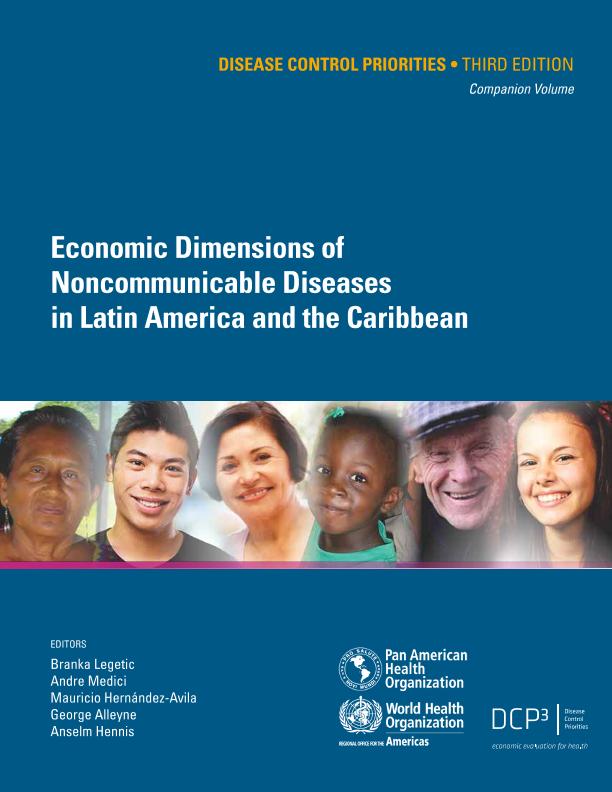Capítulo de Libro
The cost-effectiveness of interventions and policies for noncommunicable diseases and their risk factors in the Latin America and Caribbean region: A systematic literature review
Título del libro: Economic dimensions of noncommunicable diseases in Latin America and the Caribbean
Watkins, David; Poggio, Rosana ; Augustovski, Federico Ariel
; Augustovski, Federico Ariel ; Brouwer, Elizabeth; Pichón-riviere, Andres
; Brouwer, Elizabeth; Pichón-riviere, Andres ; Rubinstein, Adolfo Luis
; Rubinstein, Adolfo Luis ; Nugent, Rachel
; Nugent, Rachel
 ; Augustovski, Federico Ariel
; Augustovski, Federico Ariel ; Brouwer, Elizabeth; Pichón-riviere, Andres
; Brouwer, Elizabeth; Pichón-riviere, Andres ; Rubinstein, Adolfo Luis
; Rubinstein, Adolfo Luis ; Nugent, Rachel
; Nugent, Rachel
Otros responsables:
Legetic, Branka; Medici, Andre; Hernández Avila, Mauricio; Alleyne, George; Hennis, Anselm
Fecha de publicación:
2016
Editorial:
Pan American Health Organization; University of Washington
ISBN:
978-92-75-11905-1
Idioma:
Inglés
Clasificación temática:
Resumen
Noncommunicable diseases (NCDs) are the leading cause of death in the Americas, with cardiovascular disease (CVD) responsible for 45 percent of those deaths (Hospedales, Barcelo, Luciani, and others 2012). In the Latin America and Caribbean (LAC) region, it is estimated that from 1990 until 2020, death from CVD, including coronary heart disease (CHD), will increase by approximately 145 percent for both men and women. That compares with an increase of 28 percent for women and an increase of 50 percent for men in developed countries during the same period (Yusuf, Hawken, Ounpuu, and others 2004). The countries and territories of LAC have pioneered a strong and multisectoral response to NCD prevention and control, spearheaded by the leadership of the Caribbean countries in the 2011 United Nations HighLevel Meeting on NCDs, and continuing with the recent creation of the Healthy Latin America Coalition, which advocates for health promotion and NCD prevention. The Pan American Health Organization (PAHO) has promoted and facilitated member countries’ activities in surveillance, policy development, and guidelines for NCD prevention. The PAHO Regional Strategy and Plan of Action for the Prevention and Control of Chronic Diseases was adopted in 2012, with explicit attention to the development and economic importance of NCDs, and to the need for multisectoral involvement (PAHO 2012). In this environment, it is unsurprising that a large number of economic studies about NCDs have been produced in the LAC region. This article reviews the literature from LAC on the cost-effectiveness of interventions and policies to control and prevent NCDs. Many LAC countries use the World Health Organization (WHO) threshold to define an intervention as being costeffective, that is, whether the cost of a disability-adjusted life year (DALY) or quality-adjusted life year (QALY) is less than one times the country’s gross domestic product (GDP) per capita per life year. Most GDPs per capita in LAC range between U$S4,000 and US$12,000 (Sachs 2001). The literature on this issue reflects several characteristics unique to the LAC region: the relatively robust availability of health condition and risk factor data; a strong political and advocacy environment for population policy implementation; and an active research network on economic and public health issues, particularly on cost-effectiveness methods. As a result, this review identified a large number of relevant articles, which enables interesting comparisons across time and geography.
Palabras clave:
INTERVENTIONS
,
NCD
,
RISK
,
LATIN AMERICA
Archivos asociados
Licencia
Identificadores
Colecciones
Capítulos de libros(CIESP)
Capítulos de libros de CENTRO DE INVESTIGACIONES EN EPIDEMIOLOGIA Y SALUD PUBLICA
Capítulos de libros de CENTRO DE INVESTIGACIONES EN EPIDEMIOLOGIA Y SALUD PUBLICA
Capítulos de libros(SEDE CENTRAL)
Capítulos de libros de SEDE CENTRAL
Capítulos de libros de SEDE CENTRAL
Citación
Watkins, David; Poggio, Rosana; Augustovski, Federico Ariel; Brouwer, Elizabeth; Pichón-riviere, Andres; et al.; The cost-effectiveness of interventions and policies for noncommunicable diseases and their risk factors in the Latin America and Caribbean region: A systematic literature review; Pan American Health Organization; University of Washington; 2016; 87-106
Compartir



